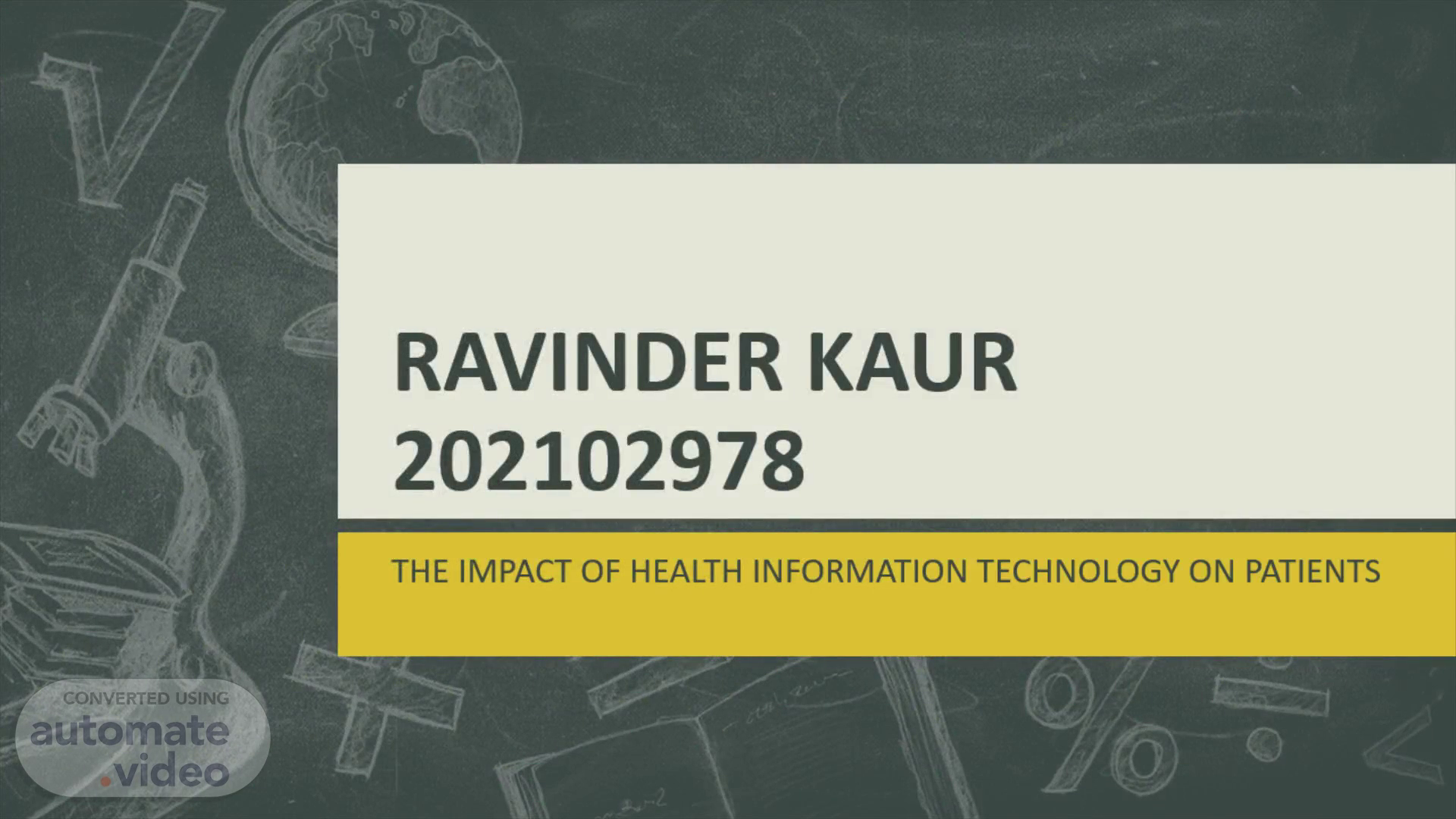
RAVINDER KAUR 202102978
Scene 1 (0s)
RAVINDER KAUR 202102978. THE IMPACT OF HEALTH INFORMATION TECHNOLOGY ON PATIENTS.
Scene 2 (8s)
INTRODUCTION. THE IMPACT OF HEALTH INFORMATION TECHNOLOGY ON PATIENTS.
Scene 3 (17s)
HEALTHCARE INFORMATION TECHNOLOGY "The application of information processing, encompassing both hardware and software, that deals with the preservation, recovery, distribution, and use of health care information, data, and knowledge for communication and decision making,".
Scene 4 (32s)
INTRODUCTION. Health information technology encompasses a range of technologies, from simple tracking to more complex decision aid ( Health Information Technology | HHS.Gov , n.d. ) and interfacing with hospital equipment. A good example being, prior to the use and acceptance of technology, medical files of patients were held on paper, which posed a significant danger of misplacement and other unforeseen events. But, because of technology improvements, there is now a prolonged shelf life available to deal with these unexpected circumstances, and files are now saved in online databases that can be accessed at whatever time. Since the IOM report, the development and use of health information technology has accelerated, with varying degrees of evidence about the impact of health information technology on patient outcomes..
Scene 5 (1m 6s)
Human mistake reduction Enhancing clinical outcomes Support better responses to health needs by providing information Data tracking throughout time Enhancing practice efficiency.
Scene 6 (1m 18s)
TYPES OF HEALTH INFORMATION TECHNOLOGY(HIT). A FEW SHALL BE DISCUSSED TO REVEAL HOW THEY IMPACT PATIENTS.
Scene 7 (1m 28s)
A Electronic physician’s orders B Bar code medication administration C Patient data management systems D Telemedicine Electronic sign out Patient electronic portals Electronic incident reporting Electronic medical record (EMR). Clinical decision support E-prescribing Electronic medication administration record Retained surgical items detectors.
Scene 8 (1m 43s)
PATIENT DATA MANAGEMENT SYSTEM. HIT. This is technology that automatically extracts data from medical devices at the bedside. ( The Organizational and Clinical Impact of Integrating Bedside Equipment to an Information System: A Systematic Literature Review of Patient Data Management Systems (PDMS) - ScienceDirect , n.d. ) A good example being patient monitors. The data is then summarized and rearranged to make it easier for healthcare practitioners to analyze it..
Scene 9 (2m 15s)
PATIENT ELECTRONIC PORTALS. HIT. A patient portal is a reliable and safe web program that allows patients to view their personal health data. Patients may schedule appointments, examine diagnostic test results, obtain medication refills, connect with physicians, and view their medical records online..
Scene 10 (2m 41s)
BAR CODE MEDICATION AND ADMINISTRATION. HIT. Bar code medication administration systems are computerized systems that integrate electronic drug administration data with bar code technology..
Scene 11 (3m 0s)
ELECTRONIC PHYSICIANS ORDERS. HIT. This comprises utilizing a computer or mobile device platform to enter physician orders, including pharmaceutical orders ( Predicting Inpatient Medication Orders From Electronic Health Record Data - Rough - 2020 - Clinical Pharmacology & Therapeutics - Wiley Online Library , n.d. ), using computer assistance..
Scene 12 (3m 23s)
Improved guidelines adherence Reduction in medical errors Reduction in adverse drug reaction No significant impact on mortality.
Scene 13 (3m 35s)
CONT’. From the above mentioned and discussed above we see that healthcare technology advancements have aided in making tasks more accessible and effective. However it is to be noted that this the most critical changes in the healthcare industry..
Scene 14 (3m 50s)
Its potential to cost reduction Monitoring of patients and their records Reducing medical errors..
Scene 15 (4m 2s)
RELEVANCE OF THE TOPIC TO THE MODULES IN THE COURSE OUTLINE.
Scene 16 (4m 41s)
LIMITATIONS, CONCLUSION AND RECOMMENDATIONS. THE IMPACT OF HEALTH INFORMATION TECHNOLOGY ON PATIENTS.
Scene 17 (4m 50s)
Heterogeneous methodologies and interventions Difference in vendors and software Language exclusions(use of mostly English).
Scene 18 (5m 0s)
CONCLUSION. Finally, health information technology improves patient safety by reducing medication errors, reducing adverse drug reactions, and encouraging patients to follow practice guidelines. There is no doubt that health information technology is an important instrument for improving the quality and safety of healthcare. However, healthcare organizations must be cautious about which technologies they invest in, as research shows that certain technologies do not improve patient outcomes..
Scene 19 (5m 21s)
RECOMMENDATIONS. To ensure that the systems are effective, suitable training must be provided to ensure that the relevant line employees are adequately trained on how to use the intended health information technology. Organizations must regularly analyze and monitor patient safety outcomes, particularly during the first deployment, to ensure that the new technology achieves its intended effect. To ensure compliance with current best clinical practices, regulatory regulations, and technical stability, organizations must ensure that health information technology are updated on a regular basis..
Scene 20 (5m 46s)
REFERENCES. THE IMPACT OF HEALTH INFORMATION TECHNOLOGY ON PATIENTS.
Scene 21 (5m 55s)
REFERENCES. Health Information Technology | HHS.gov . ( n.d. ). Retrieved June 17, 2022, from https://www.hhs.gov/hipaa/for-professionals/special-topics/health-information-technology/index.html Predicting Inpatient Medication Orders From Electronic Health Record Data—Rough—2020—Clinical Pharmacology & Therapeutics—Wiley Online Library . ( n.d. ). Retrieved June 17, 2022, from https://ascpt.onlinelibrary.wiley.com/doi/full/10.1002/cpt.1826 The organizational and clinical impact of integrating bedside equipment to an information system: A systematic literature review of patient data management systems (PDMS)— ScienceDirect . ( n.d. ). Retrieved June 17, 2022, from https://www.sciencedirect.com/science/article/abs/pii/S1386505614002470.
Scene 22 (6m 31s)
22. THANK YOU!.